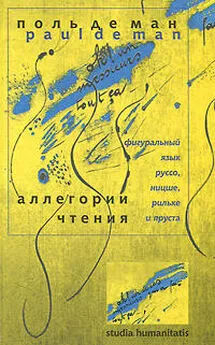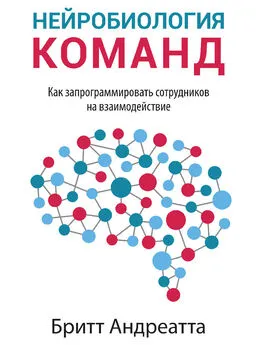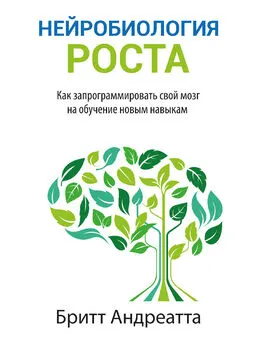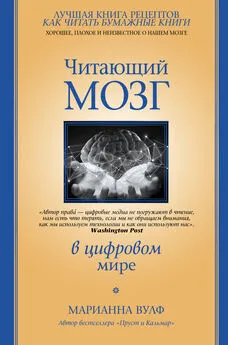Марианна Вулф - Пруст и кальмар. Нейробиология чтения
- Название:Пруст и кальмар. Нейробиология чтения
- Автор:
- Жанр:
- Издательство:ООО «Издательская Группа «Азбука-Аттикус»
- Год:2020
- Город:Москва
- ISBN:978-5-389-18966-9
- Рейтинг:
- Избранное:Добавить в избранное
-
Отзывы:
-
Ваша оценка:
Марианна Вулф - Пруст и кальмар. Нейробиология чтения краткое содержание
В этой книге, мгновенно завоевавшей мировую известность, видный американский нейробиолог Марианна Вулф исследует, как «открытая архитектура», пластичность нашего мозга помогает и мешает людям в их попытках научиться читать и обрабатывать письменный язык. Читателю предстоит увлекательное путешествие по временам и эпохам, знакомство с разнообразными иллюстрациями развития отдельного человека – от младенца, который слушает колыбельную, до настоящего эксперта – читателя произведений Пруста. Разобравшись, как эволюция и развитие чтения изменили само устройство человеческого мозга и суть нашей интеллектуальной жизни, мы поймем, что мы – это действительно то, что мы читаем.
В формате PDF A4 сохранён издательский дизайн.
Пруст и кальмар. Нейробиология чтения - читать онлайн бесплатно ознакомительный отрывок
Интервал:
Закладка:
23. A. Biemiller (1977). Relationship between Oral Reading Rate for Letters, Words, and Simple Text in the Development of Reading Achievement // Reading Research Quarterly, 13. P. 223–253; A. Biemiller (1999). Language and Reading Success. Cambridge, Mass.: Brookline; J. B. Gleason (ed.) (1993). The Development of Language. 3rd ed. New York: Macmillan.
24. Anglin. Vocabulary Development: A Morphological Analysis.
25. C. Peterson and A. McCabe (1991). On the Threshold of the Story Realm: Semantic versus Pragmatic Use of Connectives in Narratives // Merrill-Palmer Quarterly, 37 (3). P. 445–464.
26. V. Purcell-Gates (1986). Three Levels of Understanding about Written Language Acquired by Young Children Prior to Formal Instruction // Solving Problems in Literacy. J. Niles and R. Lalik (eds.). Rochester, N.Y.: National Reading Conference; V. Purcell-Gates (1988). Lexical and Syntactic Knowledge of Written Narrative Held by Well-Read-To Kindergartners and Second-Graders // Research in the Teaching of English, 22 (2). P. 128–160.
27. A. Charity, H. Scarborough , and Griffin P. (2003). Familiarity with School English in African-American Children and Its Relation to Reading Achievement; H. Scarborough, W. Dobrich , and M. Hager (1991). Preschool Literacy Experiences and Later Reading Achievement // Journal of Learning Disabilities, 24 (8). P. 508–511.
28. D. Gentner and M. Rattermann (1991). Language and the Career of Similarity // Perspectives on Language and Thought: Interrelations in Development. A. Gelman and J. P. Byrnes (eds.). Cambridge: Cambridge University Press. P. 225–277.
29. H. A. Rey (1941). Curious George. New York: Houghton Mifflin.
30. W. Kintsch and E. Greene (1978). The Role of Culture-Specific Schemata in the Comprehension and Recall of Stories // Discourse Processes, 1 (1). P. 1–13.
31. Biemiller . Language and Reading Success; Scarborough et al . Preschool Literacy Experiences and Later Reading Achievement; J. Frijters, R. Barron , and M. Brunello (2000). Child Interest and Home Literacy as Sources of Literacy Experience: Direct and Mediated Influences on Letter Name and Sounds Knowledge and Oral Vocabulary // Journal of Educational Psychology, 92 (3). P. 466–477.
32. S. Carey (2004). Bootstrapping.
33. Сьюзен Букхаймер и ее коллеги показывают, что именование объектов включает в себя подмножество участвующих в чтении процессов. Это, конечно, верно, но различия между именованием объектов и именованием букв демонстрируют и многое другое. См. главу 7, а также: S . Y. Bookheimer, T. A. Zeffiro, T. Blaxton, W. Gaillard, W. Theodore (2004). Regional Cerebral Blood Flow during Object Naming and Word Reading // Human Brain Mapping, 3(2). P. 93–106.
34. W. Benjamin (1978). Reflections. Edmund Jepheott (trans.), P. Demetz (ed.). New York: Harcourt and Brace.
35. D. Dickinson, M. Wolf , and S. Stotsky (1993). Words Move: The Interwoven Development of Oral and Written Language in the School Years // Language Development. 3rd ed. J. Berko-Gleason (ed.). Columbus, Ohio: Merrill. P. 369–420.
36. L. C. Ehri (1997). Sight Word Learning in Normal Readers and Dyslexic // Foundations of Reading Acquisition and Dyslexia: Implications for Early Intervention. B. A. Blachman (ed.). Mahwah, N.J.: Lawrence Erlbaum. P. 163–189.
37. D. Elkind (1981). The Hurried Child. Boston, Mass.: Addison-Wesley.
38. P. Yakovlev and A. Lecours (1967). The Myelogenetic Cycles of Regional Maturation of the Brain // Regional Development of the Brain in Early Life. A. Minkowski (ed.). Oxford: Blackwell Scientific; C. A. Nelson and M. Luciana (eds.) (2001). Handbook of Developmental Cognitive Neuroscience. Cambridge, Mass.: MIT Press.
39. N. Geschwind (1965). Disconnexion Syndrome in Animals and Man (Parts 1 and 2) // Brain, 88. P. 237–294.
40. M. Wolf and D. Gow (1985). A Longitudinal Investigation of Gender Differences in Language and Reading Development // First Language, 6. P. 81–110.
41. U. Goswami (2004). Comments at Mind, Brain, and Education Conference. Harvard University.
42. Elkind . The Hurried Child.
43. H. Lee (1960). To Kill a Mockingbird. New York: Warner. P. 17–18.
44. P. Fitzgerald (2004). Schooldays // Afterlife. T. Dooley (ed.). New York: Counterpoint. Цит. по: Katharine Powers (2003). A Reading Life // Boston Globe, November 16. P. H9.
45. G. L. Bissex (1980). Gnys at Work: A Child Learns to Write and Read. Cambridge, Mass.: Harvard University Press.
46. Dickinson et al. Words Move: The Interwoven Development of Oral and Written Language in the School Years. P. 369–420.
47. Chomsky . Stages in Language Development and Reading Exposure; C. Read (1971). Preschool Children’s Knowledge of English Phonology // Harvard Educational Review, 41. P. 1–54.
48. Dickinson et al. Words Move.
49. M. Pressley (1998). Reading Instruction That Works: The Case for Balanced Teaching. New York: Guilford.
50. Adams (1990). Beginning to Read. Cambridge, Mass.: MIT Press.
51. A. Burhanpurkar and R. Barron (1997). Origins of Phonological Awareness Skill in Pre-Readers: Roles of Language, Memory, and Proto-Literacy. Society for Research in Child Development meeting, Washington, D.C., April; A. Bus and M. Ijzendoorn (1999). Phonological Awareness and Early Reading: A Meta-Analysis of Experimental Training Studies // Journal of Educational Psychology, 91(3). P. 403–414; L. C. Moats (2000). Speech to Print: Language Essentials for Teachers. Baltimore, Md.: Brookes; Scarborough et al. Preschool Literacy Experiences and Later Reading Achievement.
52. L. Bradley and P. E. Bryant (1983). Categorizing Sounds and Learning to Read – A Causal Connection // Nature, 301. P. 419–421; L. Bradley and P. E. Bryant (1985). Rhyme and Reason in Spelling. Ann Arbor: University of Michigan Press; P. E. Bryant, M. MacLean , and L. Bradley (1990). Rhyme, Language, and Children’s Reading // Applied Psycholinguistics, 11 (3). P. 237–252.
53. Brady . The Role of Working Memory in Reading Disability; R. Stacey (2003). Thinking About Language: Helping Students Say What They Mean and Mean What They Say. Cambridge, Mass.: Landmark School.
54. K. Overy (2003). Dyslexia and Music: From Timing Deficits to Musical Intervention // Annals of the National Academy of Science, 999. P. 497–505; K. Overy, A. C. Norton (2004); K. T. Cronm, N. Gaab, D. C. Alsop, E. Winner , and G. Schlaug (August 2004). Imaging Melody and Rhythm Processing in Young Children: Auditory and Vestibular Systems // NeuroReport, 15 (11). P. 1723–1726.
55. C. Moritz (2007). Relationships between Phonological Awareness and Musical Rhythm Subskills in Kindergarten Children. Tufts University. Тезисы к диссертации.
56. B. Blachman, E. Ball, R. Black , and D. Tangel (2000). Road to the Code. Baltimore, Md.: Brookes; B. Foorman, D. Francis, D. Winikates. P. Mehta, C. Schatschneider , and J. Fletcher (1997). Early Intervention for Children with Reading Disabilities // Scientific Studies of Reading, 1 (3). P. 255–276.
57. Moats . Speech to Print: Language Essentials for Teachers; L. Moats (2003). LETRS. Language Essentials for Teachers of Reading and Spelling. Preliminary Version. Book 3, Modules 7, 8, 9: Foundations for Reading Instruction. Longmont, Cdo.: Sopris West Educational Services.
58. B. Hart and T. Risley (2003). The Early Catastrophe // American Educator, 27 (4). P. 6–9; T. Risley and B. Hart (1995). Meaningful Differences in the Everyday Experiences of Young American Children. Baltimore, Md.: Brookes.
59. L. C. Moats (2001). Overcoming the Language Gap // American Educator, 25 (5). P. 8–9.
60. C. Smith, R. Constantino , and S. Krashen (1997). Differences in Print Environment for Children in Beverly Hills, Compton, and Watts // Emergency Librarian, 24 (4). P. 8–9.
61. Biemiller . Language and Reading Success.
62. K. Stanovich (1986). Matthew Effects in Reading: Some Consequences of Individual Differences in the Acquisition of Literacy // Reading Research Quarterly, 21 (4). P. 360–407; A. Cunningham and K. Stanovich (1993). Children’s Literacy Environments and Early Word Recognition Subskills // Reading and Writing: An Interdisciplinary Journal, 5. P. 193–204; A . Cunningham and K. Stanovich (1998). What Reading Does for the Mind // American Educator, 22. P. 8–15.
63. C. Snow (1996). Цит. по: Kate Zernike (1996). Declining Art of Table Talk a Key to Child’s Literacy // Boston Globe. January 15. P. 1, 30.
64. P. McCardle and V. Chhabra (eds.) (2004). The Voice of Evidence in Reading Research. Baltimore, Md.: Brookes.
65. D. August and K. Hakuta (1997). Improving Schooling for Language-Minority Children. Washington, D.C.: National Academies Press; Center for Applied Linguistics (2003). Development of English Literacy in Spanish-Speaking Children: A Biliteracy Research Initiative Sponsored by the National Institute of Child Health and Human Development and the Institute of Education Sciences of the Department of Education; B. R. Foorman, C. Goldenberg, C. D. Carlson, W. Saunders , and S. D. Pollard-Durodola (2004). How Teachers Allocate Time During Literacy Instruction in Primary-Grade English Language Learner Classrooms // The Voice of Evidence in Reading Research. P. McCardle and V. Chhabra (eds.). Baltimore, Md.: Brookes. P. 289–328.
66. J. Chall (1983). Stages of Reading Development. New York: McGraw-Hill. August et al., Improving Schooling for Language-Minority Children.
67. M. Collins (2005). ESL Preschoolers’ English Vocabulary Acquisition from Storybook Reading // Reading Research Quarterly, 40 (4). P. 406–408.
68. C. Juel (2005). The Impact of Early School Experiences on Initial Reading // D. Dickinson and S. Neuman (eds.). Handbook of Early Literacy Research. New York: Guilford. Vol. 2.
69. Ibid. P. 19.
70. L-A. Petitto and K. Dunbar . New Findings from Educational Neuroscience on Bilingual Brains, Scientific Brains, and the Educated Mind // Building Usable Knowledge in Mind, Brain, and Education. K. Fischer and T. Katzir (eds.). Cambridge University Press.
71. Collins . ESL Preschoolers’ Vocabulary Acquisition from Storybook Reading.
1. Adrienne Rich (1978). Transcendental Etude // The Dream of a Common Language. New York: Norton. P. 43–50.
2. J. Chall (1983). Stages of Reading Development. New York: McGraw-Hill. P. 16.
3. M. Proust (1981). Remembrance of Things Past. C. K. Scott Moncrieff, Terence Kilmartin, and Andreas Mayor (trans.). New York: Random House. Vol. 1.
Читать дальшеИнтервал:
Закладка:










